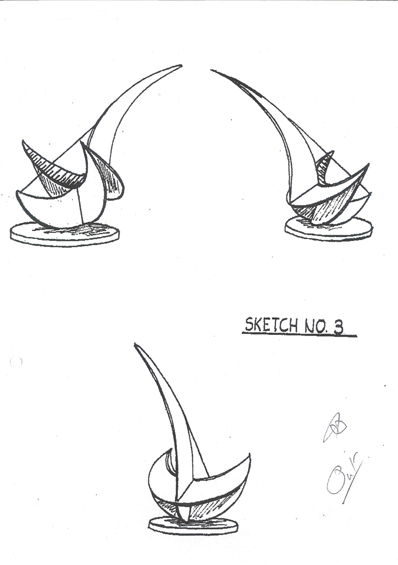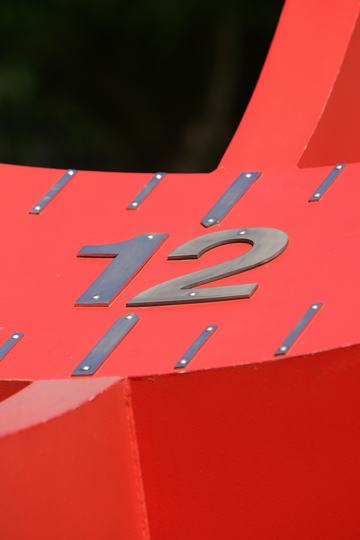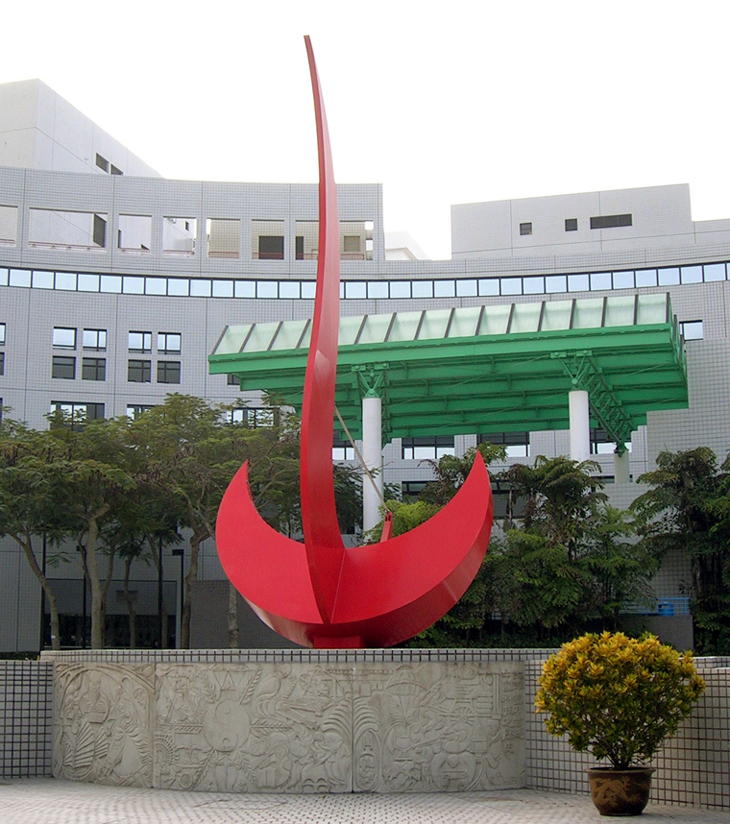"Circle of Time" - The Red Bird Sundial Sculpture at HKUST

Introduction
Entitled "Circle of Time", the sculpture standing in the center of the Entrance Piazza was commissioned by the Hong Kong Jockey Club and created by two Irish-born, Perth (Western Australia) based sculptors, the husband-and-wife team of Charles and Joan Walsh-Smith.
The center-piece sculpture is based on one of mankind's earliest scientific inventions: a sundial, i.e. by making use of the rays of the Sun to tell time. The sundial is made of steel and mounted on a paved podium of broad steps in the center of a pool of flowing water - a metaphor for the passage of time. The podium also incorporates a carved mural depicting 39 Chinese achievements in all fields of science and technology. The installation took place on 8 October 1991. The red sundial has then become an icon of HKUST.
Location

Design Theme
As extracted from the sculptors' design proposal:
"We felt that the theme should be firmly 'in context' with its setting; that it should reflect, in some way, the ambiance of its location; be relevant, and respond, both visually and metaphorically to the University. Thus, we chose to create a contemplative 'Circle of Time', an oasis within the bustling matrix of this vast complex of buildings."
"This major focal-point is a great, 8.5m tall 'Time-Piece', which is a synthesis of art and science, in that it is a sculpture which actually functions as a sundial, and a sundial which is also a sculpture, irrespective of its functional element. The soaring, sweeping, graceful forms of this center piece, is suggestive of dynamic movement and complex rhythms of shape, which use the Sun and it's shadows as an intrinsic element of its function, both visually and aesthetically."
"The 'Time-Piece' is perched atop a podium of broad steps in the center of a pool, which in turn, feeds the waterfalls. These 'cascades' are symbolic of the flow of history, and are used to frame a recessed area in the circular podium which contains a 7.0m long by 1.5m high, low relief sculpture, depicting the history of Chinese Science and Technology. Once again, the details of the relief are only discernible by the myriad of shadows cast by its highly articulated surface. This is a further development of the time-piece concept, but one which will reward the observer with many hours of contemplative enjoyment, while functioning as an educational narrative."
"We deliberately eliminated scale to create a flow of shapes and forms to simulate what we term a historical stream of consciousness. Features are juxta-positioned upon each other to approximate the swirl and flow of history, almost dreamlike in complexity. Some elements are larger than others by virtue of their form rather than specific historical function. The result is a restless shadow play teeming with the creative energy of the Chinese-People. As with the Sundial soaring above, it is the symbolic interplay of shadows which articulates the relief sculpture, the passage of time being measured both directly and indirectly both paying homage to the most recent 'Temple of Learning' of the University itself. "
Sculptors' Web Site


More Photos




Bas-relief Wall


"Narrative panels based on the history of Chinese Science and Technology - stone cast 9m long."



"Symbolic Design representing the development of Science and technology in China:
1. Iron Plough 6th Century BC
2. Segmental Arch Bridge 7th C. AD
3. Lacquer: First Plastic. 13th C. BC
4. Magnetic Compass 4th C. BC
5. Mathematics. Abacus. 13th C. BC
6. helicopter Rotor & Propeller 4th C. AD
7. Spinning Wheel 11th C. AD
8. Magnetic resonance& Induction: Drawing Steel Wire 11th C.AD
9. Canal Pound Lock 10th C. AD
10. Sailing: Fore & Aft Rigging 2nd C. AD
11. Rudder 1st C. AD
12. Trace Harness for Horses 3rd 0. BC
13. Canopied Carriage: Precursor of Umbrella 1st C. BC
14. Collar Harness 4th C. BC
15. Multistage Rocket 11th C. AD
16. Fishing Reel 3rd C. AD
17. Escapement Wheel: First Mechanical Clock 8th C. AD
18. Square Pallet Chain Pump 1st C. AD
19. Yin Yang Symbol: Essence of Matter-Particle Wave Duality Theory
20. Hexagonal Structure of Snowflakes: Cosmic Scheme of Nature
21. Manned Flight With Kites 4th C. BC
22. Seismograph 2nd C. AD
23. The Ku Ch'in: Theory of Musical Timbre 3rd C. AD
24. Woodblock & Movable Type Printing 8th C. AD
25. Equatorial & Astronomical Instruments 13th C. AD
26. Manufacture of Steel from Cast Iron 2nd C. BC
27. Bells: Music & Measurement 5th C. BC
28. Circadian Rhythms in the Human Body 2nd C. BC
29. The Stirrup 3rd C. AD
30. Cast Iron 4th C. BC
31. The Parachute 2nd C. BC
32. First Cybernetic Machine: South Pointing Carriage 3rd C. AD
33. Multi-tubed Seed Drill 2nd C. BC
34. Double-acting Piston Bellows 4th C. BC
35. The Wheelbarrow 4th C. BC
36. Porcelain 3rd AD
37. The Sliding Calipers 1st C.BC
38. Paper- Making 2nd C. BC
39. Science of Endocrinology 2nd C. BC"